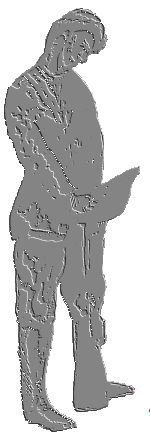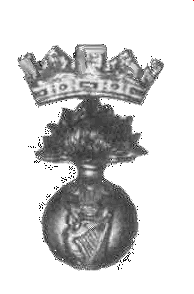 |
THE IRISH IN UNIFORM
THE ROYAL IRISH FUSILIERS |
 |
Royal Irish Fusiliers Regimental Band, Tipperary Town Barracks, 1914 (County Museum, Clonmel) |
| The Royal Irish Fusiliers'
regimental number is 87. The first regiment to be given
this number was raised in 1759 and served until 1763. It
was the Highland corps - the 87th. (Highland) Regiment of
Foot, known informally as "Keith's
Highlanders", after the Clan name of its founder.
Another regiment given the number 87 served from 1779 to
1783. The third 87th. Regiment was raised by Colonel Sir John Doyle in Ireland in 1793. It was called The Prince of Wales's Irish Regiment of Foot, and on arrival in their barracks at Portsmouth, England in 1794 the men were described by an English newspaper as "brave, hearty boys, mostly armed with Shelalehs" (meaning "shileleaghs", the Irish long cudgel, traditionally made from a branch of the blackthorn tree). Most of this regiment was taken prisoner at Bergen-Op-Zoom in 1795, and a new regiment was raised in England and then sent to The West Indies. The troops then returned to England and went to The Cape in South Africa in 1810, saw 5 years service on the island of Mauritius and then went to India in 1815. A 2nd. Battalion of the 87th. was raised in Ireland by Sir Charles Doyle in 1804. This Charles was the son of the Regiment's original Commanding Officer, Colonel Sir John Doyle. Both Battalions of the Regiment went to Portugal in1809 and took part in The Penisular War. It took part in battles at Oporto, and at Talvera and fought a defensive action at Cadiz. The Regiment's casualties at Talavera were 40%. The 2nd. Battalion of The 87th. gained great honour for its valiant action at the Battle of Barrosa, when under the command of Hugh Gough. It is probable that Hugh Gough was of the Gough family from Clonmel, County Tipperary whose later generations also became famed for their gallantry. This family has the distinction of being the only one whose members include 3 men who were awarded The Victoria Cross - Britains highest award for bravery. [SEE THE MEDALS PAGE OF THIS WEBSITE, VIA THE MAIN INDEX.] Other Battle Honours of The 87th. from The Peninsular War include Tarifa, Vittoria, Bidarossa, Nivelle, Othez and Toulouse. The 2nd.Battalion of The 87th. was disbanded in 1817. The 1st. Battalion saw service in Nepal, South of the Himalayas, from 1815 to 1816, then fought against the Pindarees, and then took part in The First Burmese War from 1825 to 1826, subsequently returning to England in 1827. In that year, the Regiment was first named The Prince of Wales's Own Irish Fusiliers, and this name was then shortened to The Royal Irish Fusiliers. The second regiment which became part of The Royal Irish Fusiliers began as The 89th. Regiment. There were 3 regiments which bore the regimental number 89, but only the third had Irish connections. The first was the 89th. (Highland) Regiment of Foot, which served from 1759 to 1765 in India,where it fought at Buxar in 1764 and put down a mutiny. The second was called The 89th. Worcestershire Volunteer Regiment of Foot, raised, as its name suggests, in the town of Kidderminster in the English County of Worcestershire. It served in The West Indies until its disbandment in 1783. In 1793, the third 89th. Regiment was raised in Ireland by Major-General William Crosbie. Very shortly after its inception, this regiment went to war in The Netherlands, where is sustained heavy casualties at Boxtel. In 1794, the 89th. went to Ireland. In 1798, when the Irish began their struggle for freedom from British rule, the 89th. fought the rebels at the Battle of Vinegar Hill. The regiment then saw service in Egypt and after the Egyptian campaign were sent to Holland, but became shipwrecked on the way. The few survivors became prisoners of war,but later returned to England and formed the core of a reconstituted regiment which saw service in Buenos Aires (Argentina), The Cape in South Africa, Ceylon (now called Sri Lanka), India and Java. It took part in the capture of the island of Java in 1811 and was granted battle honours for this action. In 1803 a 2nd. Battalion of the 89th. Regiment was raised in Ireland, which went to serve in Gibraltar before being sent to Nova Scotia in Canada. There, this Battalion took p[art in hard-fought battles from 1813 to 1814 and garrisoned Fort George and Mississaga, The battle honour "Niagara" was gained by this Irish Battalion during its Canadian service, before it returned to Europe and went on to fight in India, Burma, The West Indies, Canada again, Gibraltar, The Crimea and Africa. In 1833, the 89th.Regiment was presented with colours by The Princess Victoria, and was in 1866 given the title "Princess Victoria's Regiment" by Queen Victoria, to commemorate this event. In 1881, the Irishmen of the 2nd. Battalion with the rest of the 89th. Princess Victoria's Regiment were merged with the 87th. Regiment to become The Royal Irish Fusiliers. This regiment took part in campaigns in The Sudan, Egypt, and South Africa. The Irishmen of the 2nd.Battalion ( formerly the 87th. Regiment) gained a decisive victory over The Boers at Talana Hill, South Africa, in1899 and also took part in the Battle of Colenso. During the First World War, the Royal Irish Fusiliers 1st. and 2nd. Battalions were joined by the 3rd. & 4th. Reserve Battalions and augmented by 7 extra Service Battalions and 3 Garrison Battalions - making a total regimental strength of 14 Battalions altogether. From 1914 to 1918 the Royal Irish Fusiliers fought in France, Flanders, Gallipoli (Turkey), Macedonia (Greece), Egypt and Palestine. The 1st. Battalion landed in France at Boulogne at the commencement of World War 1. From 1914 to 1918, the 7th. & 8th. Battalions of the Royal Irish Fusiliers were stationed at Tipperary Town Barracks, County Tipperary, Ireland; where they formed part of the Headquarters (49th.) Brigade of the 16th. Irish Division. This Division had its Headquarters in Tipperary Town Barracks throughout World War 1, (see photo at the top of this page). |
| Use this button to go to the Navigation Buttons at the top of this page. | |
This
site webcrafted for The Fame of Tipperary Group,
Tipperary Town, County Tipperary, Ireland by the WebWizards© at The
Plug-in Office ®,, e-mail to plugin@iol.ie All text, backgrounds, graphics, images Copyright © 2000 WebWizards or as acknowledged. |
|